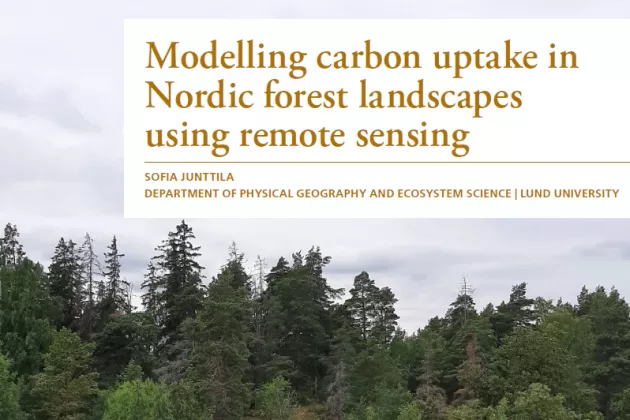Mar
PhD defense: "Modeling carbon uptake in Nordic forest landscapes using remote sensing" by Sofia Junttila

Sofia Junttila will defend her PhD thesis.
About the defense
Principal supervisor: Lars Eklundh
Assistant supervisors: Natascha Kljun, Jonas Ardö, Torbern Tagesson
Faculty opponent: Professor Scott Ollinger, University of New Hampshire, USA
Examining Committee
Professor Johan Fransson, Linnaeus University, Sweden
Associate Professor Stephanie Horion, University of Copenhagen, Denmark
Associate Professor Heather Reese, Göteborg University, Sweden
Suppleant: Zheng Duan
Chair of the defense: Anna Maria Jönsson
How to join
The defense is open to the public. If you want to join on Zoom, use the following link:
https://lu-se.zoom.us/j/65671370250?pwd=eXREUmhrNVFyc1phbUk4MXExbGJmUT09
Abstract
Boreal forests and peatlands store over 30% of the global terrestrial carbon in their vegetation and soil, but changing climate can compromise the current carbon stock. Rising air temperatures, changing precipitation patterns and increased risk of natural disturbances can impact the ability of the boreal ecosystems to absorb and store carbon, reducing their effectiveness as carbon sinks. Reliable estimates of carbon fluxes between these ecosystems and the atmosphere are crucial for understanding the ecosystem response to climate change. This thesis focuses on developing remote sensing-based models of the vegetation carbon uptake i.e. gross primary production (GPP) in Nordic forests and peatlands, and upscaling the estimates from sites to landscape and regional levels.
The results demonstrate that spectral vegetation indices EVI2 and PPI can capture the seasonal dynamics of GPP well. In general, other environmental variables that further helped to improve the results were air temperature, photosynthetically active radiation (PAR), and vapour pressure deficit (VPD) that expresses atmospheric demand for water. Another finding was that the spatial resolution of the satellite instrument had less influence on the accuracy of GPP estimates than the model formulation and selection of the input data. The result suggested that vegetation productivity can be monitored at various scales with high accuracy using satellite remote sensing data. Fine-scale estimates are beneficial when monitoring individual forest stands or spatially heterogeneous ecosystems like peatlands.
Various model formulations were tested to estimate GPP with remotely sensed data. The site-specific calibration gave more accurate results, but the single parameter set per ecosystem type was more applicable for upscaling GPP for a larger area. In addition, we found that PPI performed well and provided a useful tool for estimating GPP at local and regional scales. Despite the good agreement with the eddy covariance-derived GPP, the models could be further improved to capture the spatial heterogeneity between the sites by adding e.g. soil moisture data. Finally, we applied a PPI-based model to estimate annual GPP in Sweden’s forests and peatlands with a 10-meters spatial resolution. This thesis highlights that satellite remote sensing has a great potential for monitoring variations changes in vegetation carbon uptake in Nordic forest and peatland ecosystems.
About the event
Location:
Room "Världen" (no 111), Sölvegatan 10, Geocentre I 1st floor, Lund, Sweden
Contact:
sofia [dot] junttila [at] nateko [dot] lu [dot] se

